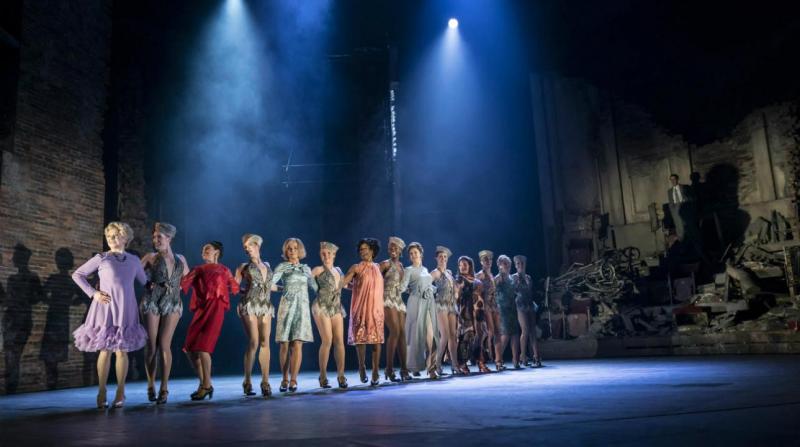Song Insights: 'Who's That Woman?', FOLLIES
|

Lord, lord, lord, how is there only one week left of Follies at the National?! As Dominic Cooke's production starts to wind down, so too does our Song Insights series. This week, we're looking at a show-stopping dance routine from the musical: "Who's That Woman?"
Choreographer Bill Deamer and MD Nigel Lilley reflect on the details that go into this number, which took nine weeks to bring together.
Nigel Lilley: Or "The Mirror Song" (as it is known) is one of the highlights of the reunion party. The ladies getting their tap shoes back on after many years and performing a number they used to sing as a chorus every night.
Like many of the party numbers, it starts off with just a piano accompaniment, as if it's the cocktail pianist at the party accompanying the number. Then the full orchestra creeps in bit by bit, almost imperceptibly to the audience.
("Beautiful Girls" and "Rain on the Roof" also start with solo piano in our production.)
How did this number come together in rehearsals?
Bill Deamer: Originally we had nine weeks, because with all the staging and choreography you're dealing with so many elements: you're dealing with tap, complex rhythms and a moving revolve that has to be timed.
And of course here, the National have a revolve in the rehearsal room. So we could time dance sequences and create accurate cues for the moving revolve. But that in itself is a week's work before you even start choreographing.
So it took the nine weeks!
Piecing it all together, Nigel and Nick were just wonderful. They would say, "Now how can we help you there, with building the correct tempo for the tap?". And I said, "Just play the tempo as it's marked in the score and we can find what works for my choreography as we rehearse".
Because you know, sometimes slowing it down to learn dance steps makes it harder. I have to find out where the choreographic rhythms are and where they're actually going to sit in the rhythm of the music.
And to match that fast rhythm, you've got that fast tap routine.
Bill Deamer: Exactly.
The dexterity of the tap, it's very fast footwork. I actually choreographed it for the younger ghosts. But now all the ladies are doing it as well. And I haven't changed or simplified a step. What was brilliant is they all had tap on their CVs coming into auditions, and we also did a tap boot camp so that I could see what possibilities there could be choreographically. We worked with all of them and worked them hard.
But Dominic and I always stood together, even back during the casting process. We'd say "If they can't really dance it, then it's not going to work for them". His support was amazing. That gives me as the choreographer such confidence that he believes in me and I believe in him as the director. And the results speak for themselves.
So it's very fast tap with many off-beat, syncopated rhythms and I'm actually choreographing tap beats in the gaps of the dance orchestration. That's not easy. But that's how I work, I've always been able to do it with tap: I'm always able to find a rhythm in there somewhere and also find the choreographic story that goes with it.
Nigel Lilley: Just as "One More Kiss" is a song where an older character duets with her younger self, here we have the older ladies at the reunion dancing with (and at points literally being mirrored by) their younger selves.
We talked a lot about muscle memory in early music rehearsals, that feeling of singing a song which the character may not have sung out loud for many, many years. And yet the words and melody are like old friends.
In the case of "Mirror Mirror", this is a song that they may have performed night after night throughout their time as Follies girls, similar to performing eight times a week over a long contract in a musical.

What does this larger group number offer, in terms of characterisation?
Bill Deamer: The thing with the mirror number is, because of the way the show is written, the ladies only really get one chance of showing off any of the dancing that they did when they were Follies girls.
For me that is so important, because although the show has wonderful solo numbers and some very famous torch songs, the show is about Follies girls - and all Follies girls danced in some fashion or another.
And in this version, you utterly believe that these ladies were dancers.
I love it when you hear, "Wow... those ladies can still do it!". That was exactly the premise of why I took the job, because I believe that's what a dancer's life is. It's in their DNA when they dance. They never forget.
So even if they can't kick their legs above their head, they can still kick and they can still kick in time and dance with style. That's really where I came from with the number and boy, did I push those ladies!
Nigel Lilley: With those mirror images with their younger counterpart, you have to ask: what has time done to change the relationship of the character to the lyrics they are singing?
Having sung breezily about a woman "So clever but ever so sad" and "Dressing for one more spree", at the end of the number, Dawn (who plays Stella Deems) has an amazing moment of realisation. It's almost like it's the first time the lyrics have really hit: "Lord, Lord, Lord, Lord, Lord - that woman is ME".
With the advantage of age and experience can she recognise the sadness of the lyric: the loneliness of trying to get through life in a social whirl, but without really making connections with others.
And it's not just a dance challenge, it's vocally a challenge too.
Bill Deamer: Yes. To do all that, plus singing!
And somehow, Dawn just gives more and more every time I see the number.
Her breath control is extraordinary; she is really singing and dancing full out. By the time she gets to the end of the number, the lungs are really in full swing, when she really hits that final, "That woman is ME!" - just wonderful.
For this number, there are the 14 of them on stage. Originally, we'd added other girls and boys into the routine, to create a big company number. That was actually a musical theatre build, which got a great response, but it wasn't a build that was right for the number, the storytelling and the concept of the show.
Because the number is about those seven women and their younger selves, telling their stories, and in particular Stella.
Nigel Lilley: The dance break in "Who's That Woman" is also a great showcase for our extraordinary Follies orchestra.
We are a 21-piece band, which is a luxury for a show these days. We use the original dance music written by John Berkman, who was a brilliant pianist and dance arranger, and his work on Follies is incredible.
He would have worked closely with the original choreographer Michael Bennett, taking themes from "Who's That Woman" and developing them to create a magical dance break with lots of rhythmic variation for the dancers to work with.
It reminds you of a Fred and Ginger fantasy sequence or one of those grand Busby Berkeley numbers.
johanpersson.jpg)
What inspired the number?
Bill Deamer: I'm a great fan of the Hollywood movie: Busby Berkeley, Fred Astaire, Gene Kelly, all those wonderful performers; without them, we wouldn't be doing this today. And I find it totally fascinating - I mean, Fred and Gene were way ahead of their time. So I did my research.
But then Stephen Sondheim's music actually conjured up pictures of all of that: the Goldwyn Girls and all those Hollywood movie greats. And then I sort of absorbed all of that and made a style of my own, which is what I did with Top Hat.
And I think the 20s, 30s, 40s, 50s, 60s, all of those periods are not separate and all grow into one another; it is just absolutely fascinating the way dance grew and changed and developed through that time. And I've just taken all of that and created our Follies choreography.
And not just dance, but even body language. Each one of those ladies on stage stands in the period of their Follies character. I can show you, but it won't come across written!
But the hand placements, the feet, the bevel, every one of those girls stands in their period. That's the detail of the show. And it's because the sheer level of detail of the book and score that you have to honour that in the staging and choreography.
Nigel Lilley: Finally, the icing on the cake is Jonathan Tunick's work, the orchestrator most closely associated with Sondheim.
We were incredibly lucky to have Jonathan join us for band rehearsals the first time we mounted the show. He was able to give us such insight into the charts - very specific ways of phrasing for the instrumentalists - advice on dynamics, stylistic choices.
We felt incredibly lucky.
And you're choreographing to the original arrangements.
Bill Deamer: If it ain't broke, you don't need to fix it!
Those arrangements by Jonathan and the dance arrangements by John are without a doubt some of the greatest dance and musical orchestrations I have ever heard. They absolutely tell you why you're there and what you need to do. This is a period show, a classic show, but it's not 'old-fashioned'. It is always a joy to visit and rework classic period musicals.
Follies is a classic musical masterpiece, but you're always taking a fresh look at what you do. You can't just do what was done before. You're always trying to move things on. And when you've got a room of 47 triple threats, you can actually do that.
Follies at the National Theatre until 11 May
Photo credit: Johan Persson
Videos
